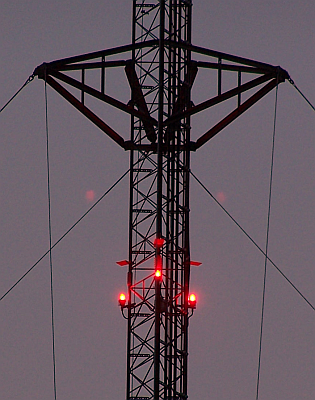Birds and Tower Lights
Tower Lighting Change Requests FAA and FCC Procedures
FAA and FCC Procedures
Site Security Lighting
Questions
Birds and Tower Lights
For more than 50 years, migratory birds have been documented to collide with communications towers, as well as other tall structures. Biologists have conducted focused studies (http://tinyurl.com/zq6noku) and estimate that approximately 7 million birds collide with towers in Canada and the United States every year during their spring and fall migrations. A documented 239 species of birds have collided with towers resulting in fatalities. Perhaps not surprisingly, wildlife biologists have concluded that tall, guyed towers are involved in more bird collisions than shorter, self-supported towers.
Non-flashing red lights, such as L-810 side-marker lights, can attract birds when illuminated. This puts the birds at greater risk of collision with guy wires, tower structural members, and antennas that are hard to see in dim light. Birds are much less attracted to flashing lights on towers, such as L-864 (red) or L-865 (white) obstruction lights.
The FAA and the FCC recognize this concern, and have implemented steps to reduce bird collisions through modifications in red tower lighting. The Federal Aviation Administration (FAA) has revised its advisory circular that prescribes tower lighting to eliminate new use of L-810 steady- burning side lights on towers taller than 350 feet (106.7 meters) above ground level (AGL), or to make L-810 lights flash on towers 150 to 350 feet (45.7 -106.7 meters) AGL.
These changes can reduce bird collisions by as much as 70%, particularly for migratory birds. Extinguishing L-810 lights also reduces costs for the tower owner.
Tower Lighting Change Requests
Tower owners may now request a “lighting deviation” from the FAA that can be used to extinguish or eliminate L-810 steady-burning side lights from an existing registered tower greater than 350 feet AGL and to flash the L-810 lights on towers 150 to 350 feet AGL. Typically the FAA quickly approves such a request. The steps for making a lighting deviation request are set forth below.
Once approved by the FAA and FCC, the tower owner can implement the approved tower lighting changes. Extinguishing L-810 lights on towers taller than 350 feet AGL usually can be accomplished in the building at the tower base and does not require climbing the tower. Maintenance costs for those lights are immediately eliminated. No costs will be incurred by tenant licensees, and no FCC licenses will need to be reissued, since the FCC Antenna Structure Registration Number specified on those licenses will remain unchanged. For towers 150 to 350 feet tall AGL, reprogramming L-810 lights to flash typically requires use of LED lighting systems.
FAA and FCC Procedures
Follow these steps to obtain FAA and FCC approval before making lighting changes:
- File a Marking and Lighting study electronically with the FAA at Obstruction Evaluation / Airport Airspace Analysis (OE/AAA), requesting the elimination or omission of steady-burning lights (L-810) or requesting that steady-burning lights flash, via Form 7460-1, Notice of Proposed Construction or Alteration. Designate structure type: "Deviation from Red Obstruction Light Standards". The FAA will assign a FAA Study Number to the request.
- Once approved by the FAA, file FCC Form 854 with the FCC for the current FCC Antenna Structure Registration Number (ASRN), via the Antenna Registration System (ASR) . Please select "MD – Modification" and choose the appropriate FAA Lighting Style. The FCC will typically approve the application and modify the registration within 24 hours.
- If the FAA grants a lighting deviation referencing an advisory circular other than 70/7460-1L, select "3. Other" and describe the lighting in the field provided. If the FAA issues a new Study referencing 70/7460-1L, select the lighting style that corresponds to the lighting in the FAA Study.
- If the FAA grants a lighting deviation referencing an advisory circular other than 70/7460-1L, select "3. Other" and describe the lighting in the field provided. If the FAA issues a new Study referencing 70/7460-1L, select the lighting style that corresponds to the lighting in the FAA Study.
- When the lighting change for a tower has been granted by the FCC via ASR, the steady-burning, side-marker, L-810 tower lights can be extinguished on towers greater than 350 feet AGL, or reprogrammed to flash in concert with L-864 lights on towers 150 to 350 feet AGL. This is typically accomplished in the tower transmission building and does not ordinarily require climbing the tower.
- Per the FAA requirements, flashing red lights should continue to flash at the rate of 30 FPM (+/- 3 flashes per minute).
Site Security Lighting
The elimination of continuously burning security lights on the buildings under towers can reduce bird attraction to the site. The FCC encourages the use of motion sensor-triggered security lighting under communications towers, if security lighting is required.
Questions
Questions may be referred to Nancy Fox-Fernandez, Staff Biologist, Federal Communications Commission, Nancy.Fox-Fernandez@fcc.gov.